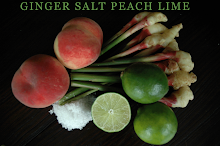On face value, this offense might seem trivial. I paid for the cherries, after all. But with each little sucked stone I admit my part in the conspiracy – a lacework of trees and pickers and tarps and Cherry Queens and trucks and airplanes and dollar bills, the American kind. So Barbara Kingsolver might tell me, and she’d be right. I bought these cherries at an American-run grocery store in South Korea. I have no idea where the cherries came from or how they got from a tree to my hotel room other than the last half-mile, which I drove. All I know is that I plan to eat every one and feel tickled pink about it.

Cherries mean summer. Their squat, tumbling entrance into the world each year hardly competes in a season laden with thundering movies, splashing kids and flipping flops. A few years ago I started listening more carefully, especially when my taste buds were talking. Each June this is what they said: We’ve only got a couple of weeks to do this thing, a month at most. Get to the grocery store and buy as many fresh, sweet cherries as you can.
That was when I lived in central New York, and the cherries at my super-sized grocery store came from Michigan or Washington, I’d guess now. That sin of shipping and guzzling un-local food is the argument in Kingsolver’s latest book, “Animal, Vegetable and Miracle.” It’s hard to find fault with the notion, especially when much of the United States is rich with farmland, local produce and farmers’ stands. She admits that you can’t grow food in all places, and she does something about it. She and her family leave the artificial food chain in the American southwest for the consumable progeny of Virginia. (She does not admit, however, how her garden or her farming neighbors managed to produce rice paper wrappers during her family’s year eating from the local food economy. We all have our secrets in the kitchen.)
After my family gave up gardening when I was 10 or so, we went to the grocery stores for most things to eat. Years later when I started making my own groceries and dinners, I looked forward to this weekly habit as a way to experiment with vegetables that don't traditionally grow in the American south. Portobello mushrooms on a summer grill. Roasted asparagus with Christmas dinner. Stuffed artichokes any ol’ time you felt like it. And if work or life was too complicated, the old, easy stand-bys always stood by: broccoli, bananas, eggplants, peppers, lemons. As I’ve aged, the conspiracy and my part in it have ripened so that it’s possible to find delicious cantaloupe year-round. In more than one winter I’ve marveled at the juicy melon I’m eating.
Not so with cherries. They remain one of the few hold-outs in this one-season-fits-all way of produce. Even in the midst of massive grocery chains and unhealthy government farming subsidies, fresh cherries remind us that weather and climate and location, to a degree, matter. Occasionally, other reminders of natural cultivation pop up, such as litchi nuts in late April, or corn after the Fourth of July. For me, spying those tilted boxes of red-black balls at the store cracked louder than fireworks. Summer is here, go sit on the porch and enjoy the late, lazy evening.
This specific attention to the growing calendar does nothing to solve the problem – or, let’s face it, lessen the convenience – of refrigerated trucks and food with frequent flyer miles. The appearance of cherries at a major market romanticizes the idea of seasonal produce and local farming. And like any short-term love affair, it inevitably brings more complications than you bargained for. Unless you live in Michigan or the American northwest, those cherries didn't come from a tree near you. But still, give up cherries cold turkey? What a cruel, uncheerful world.
This summer, unlike many past, I had planned on just that. In Tokyo the beautiful and shrink-wrapped cherries can cost $10 for less than a pint, a fact I couldn't wrap my wallet around. But a week later I found myself on a business trip in Korea ogling cherries, in July no less, at only $4 a pound. My hand reached for the plastic bag before I knew what was happening. Now I’m trying to decide how much I regret that decision. The cherries are good, I’m only half-sorry to say. Part of me is having a fabulous, healthy dessert.
Part of me is craving plums. Back in Tokyo, I passed on the expense of cherries and, on a friend’s advice, waited for plum season to arrive. In early July, tennis-ball-sized plums appeared with apple-tart green skins. On my first bite, I realized I’d honestly never eaten anything that glowed so rosy or tasted so plummy. It was a wonderful discovery and, relative to other prices in a Japanese produce aisle, a reasonably affordable one. I hope they are still in season when I get home in a couple of weeks. Otherwise, I'll be waiting until next July for the plums to return. And that, I suppose, is the point.






